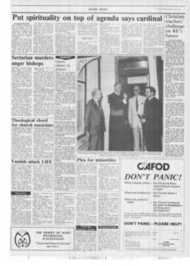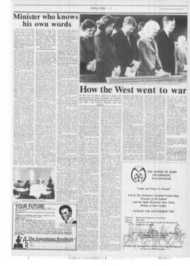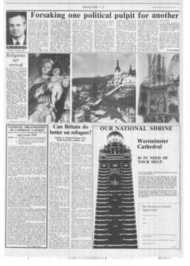Page 8, 26th July 1991
Page 8

Report an error
Noticed an error on this page?If you've noticed an error in this article please click here to report it.
Tags
Share
Related articles
Screen Swap For Naughty Nudes Many Minutes
Crafts Revived In A Chapel At The Angel
Ayres' Obituary Inscribed In London Stone
Coming
Spirituality Combines With Art To Recall Ages Past
Art historians at the touch of a screen
GALLER I ES
by Leigh Hatts
THE National Gallery is built Over the burial ground of St Mary Rouncivall Hospital, a house of St Mary Roncevalles in Navarre which remains an important stop on the St James' pilgrimage road to Compostella. As yesterday was the feast of St James the Great there can be no more suitable name with which to test the National Gallery's new technology.
The Micro Gallery, in the newly opened Sainsbury Wing but sponsored by American LExpress, is a computer
1 information room containing background information on every , painting in the collection. Users : need no computer experience and no knowledge of art history. You simply touch a name on the screen to call up a potted biography or an explanation. Place your finger on the word "mass" and up comes the definition.
There are 66 saints on file. For
1 St James the screen provides a 50 word life and iconographic details alongside five postage stamp size tcolour reproductions of paintings f
eaturing the saint. Touch a
!painting for a full description and a larger reproduction appears. (In fact the programming is not quite complete and visitors will find a sixth St James among Nardo's Three Saints in the new room number 54.)
Apart from general reference, there are "artist", "picture types" and "historical atlas" sections here you might touch Venice on the master map and select the 16th century for a local map and details of painters. This resource is far in advance of those in other European galleries and will open up the collection to many. Questions you never like to ask are answered in the privacy of the work station.
All this is free except for print outs of the pages (a chargecard buys five) but actually to see a painting you can call up a personalised gallery map showing where it is and have a print-out free.
On the wall of the Sainsbury entrance, and even more prominent than the lettering unveiled by the Queen, are the words "admission free". Director Neil MacGregor is firm about resisting entrance charges and the only ticket desk will be for loan exhibitions.
What appears to be a holy water stoup in the foyer is for voluntary donations but in the galleries comparison with a cathedral is irresistible. "We wanted to give an impression of what it's like in an Italian church to see great altarpieces all around you," admits the director. The new wing gives a choice of how to see the works.
At the top of the staircase (which recalls a Florentine palace) you turn to see a weeping "chancel" with Cima's altarpiece
of The Incredulity of St Thomas at the end of the grey Italian sandstone perspective. Walk :loser and you pass Leonardo's Virgin of the Rocks in a "side chapel". The flanking "sacristy doors" lead to the new home for Leonardo's cartoon of the Holy
Family (featuring today's saint, Anne).
The Sainsbury Wing, designed by the Americans Robert Venturi and Denise Scott-Brown, is an international building which at last makes the National Gallery feel more than a municipal museum.
Early criticism by architectural writers cannot diminish it. The only shame is that but for Sainsbury impatience with 50 years of dithering we should never have had the building. Even one of the Sainsbury brothers says that the government rather thaa private individuals should pay fcr such projects.
The National Gallery is open daily with late weekday viewing to 8pm until August 15.
blog comments powered by Disqus











